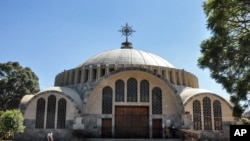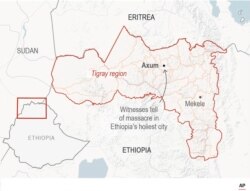Guesh Liasanewerk’s family had just gathered to celebrate the birth of his sister’s child born four days earlier. Sitting in their home in a rural area outside of the historic Ethiopian city of Axum, they were interrupted by Eritrean soldiers storming in. Within moments, the men, including his 78-year-old father and 17-year-old brother, were executed by gunshots. Amnesty International has called the Axum killings, which took place Nov. 28 and 29, a “massacre” in a new report.
“There are people who lost three or four people in our neighborhood,” Guesh told VOA’s Tigrigna service in one of the multiple interviews conducted with residents of Axum weeks before Amnesty International’s report. “Many people were killed, including monks in the monasteries.”
In the city, Guesh said, many young people were killed.
“Bodies in the city were laid out for three days because they didn’t have anyone to bury them. Some of the bodies were taken with a carriage after four days. My cousin was found after four days and they identified him using his identification card,” he added, making his cousin the third family member allegedly killed by Eritrean soldiers. All his family members were buried in one grave, he said. “I hope to get justice for my parents and my family.”
‘Hundreds, hundreds of people’
The Amnesty International report details the systematic killing of hundreds of civilians in Axum, in the country’s Tigray region. Gathering information from interviews with more than 40 survivors and witnesses of the attack as well as others with knowledge of the events, the organization collected consistent accounts of looting, indiscriminate shelling and extrajudicial killings. The human rights group said the events may constitute a crime against humanity.
Report co-author Jean-Baptiste Gallopin said the massacre began Nov. 28 after a small group of militiamen loyal to the Tigrayan People’s Liberation Front, or TPLF, an armed movement that later became one of four political parties in a ruling coalition, attacked a temporary mountainside Eritrean base.
“In retaliation for this attack, Eritrean forces shot wantonly at civilians and killed, we believe hundreds, hundreds of people over the course of roughly 24 hours,” Gallopin told VOA. “They also went around carrying house-to-house searches, and dragging mostly men out of their homes and shooting them on the streets or killing them in their homes.”
Helina Afewerki, who grew up in Axum but lives in Addis Ababa, traveled to Axum and attended funerals of neighbors. She said she heard consistent accounts of Eritrean soldiers going door to door killing mostly men.
“In my neighborhood alone, Enda Mikael, I have confirmed 26 people who were killed,” she told VOA. “They were targeting the men and asking for them. If people didn’t open their doors when they knocked, they said, ‘We will throw bombs.’”
Another witness who is an Axum resident but did not want to reveal his name for fear of reprisal said there were some Tigrayan militiamen who were shooting in the beginning but when the Eritrean soldiers came in, they started to indiscriminately kill. “They came in with tanks,” he said.
Eritrea’s Minister of Information Yemane Gebremeskel denied the Amnesty International report Friday and called it a fabrication.
“Eritrea is outraged and categorically rejects the preposterous accusations leveled against it by Amnesty International in a fallacious report issued today,” he said in a tweet. “It must be underscored that Amnesty made absolutely no attempt to seek any information from Eritrea.”
Ethiopia’s minister of foreign affairs posted on its Facebook page that all blame goes to the TPLF. “None other than the TPLF should, therefore, take the primary responsibility for what subsequently unfolded in the region. This outlaw group has been engaged in ambush, assassination, and other criminal activities.”
An Eritrean soldier speaking to VOA’s Tigrigna service denied the charges.
“We had no aim or goal to target civilians. In fact, our understanding is that the people of Tigray were coming toward us looking for a safe haven or seeking shelter with us,” he said asking that his name not be used.
“Even in Axum, there were situations where some people were shooting and some were looting. There were times that required for an appropriate response, but there was nothing that aimed at the civilian population. I am an eyewitness myself. I was there myself,” he said.
‘We have a trust deficit’
There are others who cast doubt on the accuracy of the report.
“I think that it is important to get evidence and to put it forward,” Bronwyn Bruton, the director of programs and studies at the Atlantic Council’s Africa Center told VOA. “The evidence would hopefully come from investigators going on the ground. But in order to get those investigators on the ground, we have political problems that we need to solve. We have a trust deficit. We have the lingering ghost of TPLF which was the indispensable partner of the U.S. for so many years.”
Gallopin said Amnesty International’s methodology in the report was meticulous. Researchers spent 11 days in the Hamdayet refugee registration center in eastern Sudan speaking to witnesses who fled the area. The organization corroborated locations of shelling and burial sites using satellite imagery analyzed by its Crisis Evidence Lab. They have also reviewed videos taken in the area showing evidence of the attacks and were able to geolocate them.
“So clearly the casualty figure is very high and this is the highest, the most significant massacre that’s been documented so far in the conflict in Tigray and also the most systematic documentation of violations by Eritrean forces in Tigray,” Gallopin said.
Gallopin said he fears other abuses are going undocumented due to the difficulty in collecting information.
“It’s very important to bear in mind that given the considerable restrictions on access, we don’t have a clear picture of the overall scale of violations. And this could be just the tip of the iceberg,” he said.
VOA Tigrigna service’s Tewelde Tesfagabir contributed to the report.











